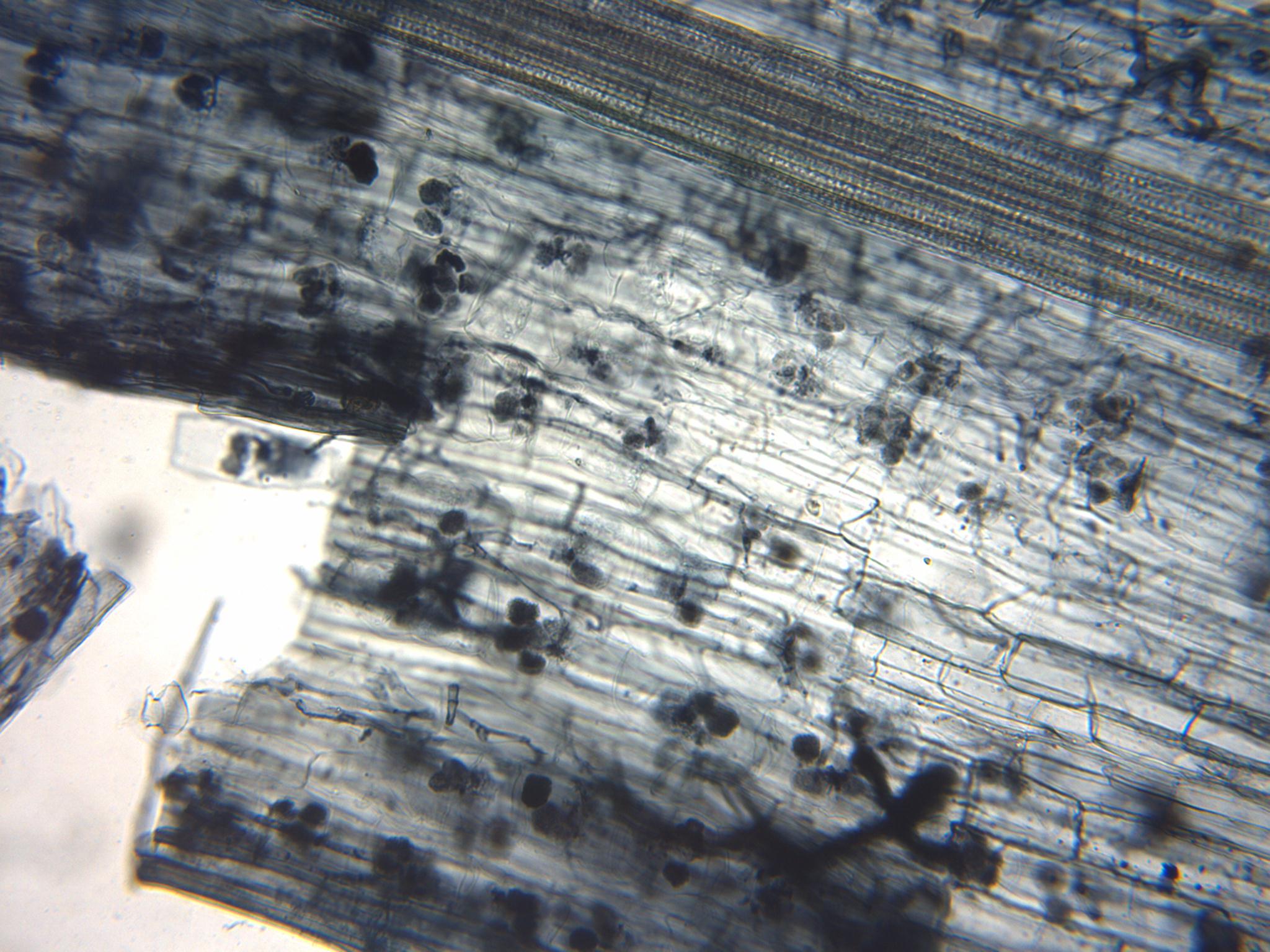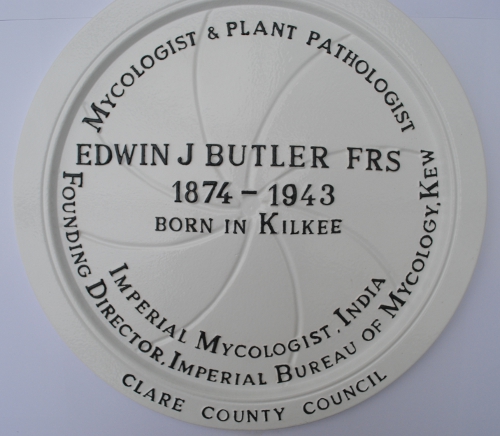|
Glomus Aggregatum
''Glomus aggregatum'' is an arbuscular mycorrhizal fungus used as a soil inoculant in agriculture and horticulture. Like other species in this phylum it forms obligate symbioses with plant roots, where it obtains carbon (photosynthate) from the host plant in exchange for nutrients and other benefits. Morphology ''G. aggregatum'' has sporocarps containing spores which are not closely grouped. Spores are usually pear-shaped or spherical and measure between 40 and 85 μm in diameter, whereas sporocarps can be 200-1800 μm X 200-1400 μm in diameter. Spore color ranges from pale yellow to a darker yellow-brown or orange-brown. Spores can be contained in either one or two cell walls, but if there are two, the outer wall is always thicker. A second type of spore wall thickening has been observed in ''G. aggregatum'' spores wherein the wall undergoes localized thickening in one hemisphere or a smaller space. This can happen in multiple locations on a single spore and can contribute to ... [...More Info...] [...Related Items...] OR: [Wikipedia] [Google] [Baidu] |
Arbuscular Mycorrhiza
An arbuscular mycorrhiza (AM) (plural ''mycorrhizae'', a.k.a. ''endomycorrhiza'') is a type of mycorrhiza in which the symbiont fungus (''AM fungi'', or AMF) penetrates the cortical cells of the roots of a vascular plant forming arbuscules. (Not to be confused with ectomycorrhiza or ericoid mycorrhiza.) Arbuscular mycorrhizae are characterized by the formation of unique structures, arbuscules and vesicles, by Glomeromycota and Mucoromycota, sister clades of the more well-known and diverse dikaryan fungi (all three are together called "symbiomycota"). AM fungi help plants to capture nutrients such as phosphorus, sulfur, nitrogen and micronutrients from the soil. It is believed that the development of the arbuscular mycorrhizal symbiosis played a crucial role in the initial colonisation of land by plants and in the evolution of the vascular plants. It has been said that it is quicker to list the plants that do not form endomycorrhizae than those that do. This symbiosis is a ... [...More Info...] [...Related Items...] OR: [Wikipedia] [Google] [Baidu] |
Soil Inoculant
Microbial inoculants also known as soil inoculants or bioinoculants are agricultural amendments that use beneficial rhizosphericic or endophytic microbes to promote plant health. Many of the microbes involved form symbiotic relationships with the target crops where both parties benefit ( mutualism). While microbial inoculants are applied to improve plant nutrition, they can also be used to promote plant growth by stimulating plant hormone production. Although bacterial and fungal inoculants are common, inoculation with archaea to promote plant growth is being increasingly studied. Research into the benefits of inoculants in agriculture extends beyond their capacity as biofertilizers. Microbial inoculants can induce systemic acquired resistance (SAR) of crop species to several common crop diseases (provides resistance against pathogens). So far SAR has been demonstrated for powdery mildew ( ''Blumeria graminis'' f. sp. ''hordei'', Heitefuss, 2001), take-all ( ''Gaeumannomyces grami ... [...More Info...] [...Related Items...] OR: [Wikipedia] [Google] [Baidu] |
Agriculture
Agriculture or farming is the practice of cultivating plants and livestock. Agriculture was the key development in the rise of sedentary human civilization, whereby farming of domesticated species created food surpluses that enabled people to live in cities. The history of agriculture began thousands of years ago. After gathering wild grains beginning at least 105,000 years ago, nascent farmers began to plant them around 11,500 years ago. Sheep, goats, pigs and cattle were domesticated over 10,000 years ago. Plants were independently cultivated in at least 11 regions of the world. Industrial agriculture based on large-scale monoculture in the twentieth century came to dominate agricultural output, though about 2 billion people still depended on subsistence agriculture. The major agricultural products can be broadly grouped into foods, fibers, fuels, and raw materials (such as rubber). Food classes include cereals (grains), vegetables, fruits, cooking oils, meat, milk, ... [...More Info...] [...Related Items...] OR: [Wikipedia] [Google] [Baidu] |
Horticulture
Horticulture is the branch of agriculture that deals with the art, science, technology, and business of plant cultivation. It includes the cultivation of fruits, vegetables, nuts, seeds, herbs, sprouts, mushrooms, algae, flowers, seaweeds and non-food crops such as grass and ornamental trees and plants. It also includes plant conservation, landscape restoration, landscape and garden design, construction, and maintenance, and arboriculture, ornamental trees and lawns. The study and practice of horticulture have been traced back thousands of years. Horticulture contributed to the transition from nomadic human communities to sedentary, or semi-sedentary, horticultural communities.von Hagen, V.W. (1957) The Ancient Sun Kingdoms Of The Americas. Ohio: The World Publishing Company Horticulture is divided into several categories which focus on the cultivation and processing of different types of plants and food items for specific purposes. In order to conserve the science of horticultur ... [...More Info...] [...Related Items...] OR: [Wikipedia] [Google] [Baidu] |
Sporocarp (fungi)
The sporocarp (also known as fruiting body, fruit body or fruitbody) of fungi is a multicellular structure on which spore-producing structures, such as basidia or asci, are borne. The fruitbody is part of the sexual phase of a fungal life cycle, while the rest of the life cycle is characterized by vegetative mycelial growth and asexual spore production. The sporocarp of a basidiomycete is known as a ''basidiocarp'' or ''basidiome'', while the fruitbody of an ascomycete is known as an '' ascocarp''. Many shapes and morphologies are found in both basidiocarps and ascocarps; these features play an important role in the identification and taxonomy of fungi. Fruitbodies are termed ''epigeous'' if they grow on the ground, while those that grow underground are ''hypogeous''. Epigeous sporocarps that are visible to the naked eye, especially fruitbodies of a more or less agaricoid morphology, are often called mushrooms. Epigeous sporocarps have mycelia that extend underground far ... [...More Info...] [...Related Items...] OR: [Wikipedia] [Google] [Baidu] |
Edwin John Butler
Sir Edwin John Butler (13 August 1874 – 4 April 1943) was an Irish mycologist and plant pathologist. He became the Imperial Mycologist in India and later the first director of the Imperial Bureau of Mycology in England. He was knighted in 1939.''Oxford Dictionary of National Biography'' http://www.oxforddnb.com/ During his twenty years in India, he began large scale surveys on fungi and plant pathology and published the landmark book ''Fungi and Disease in Plants: An Introduction to the Diseases of Field and Plantation Crops, especially those of India and the East'' (1918) and has been called the Father of Mycology and Plant Pathology in India. Background and education E.J. Butler was born in Kilkee, County Clare, Ireland the son of Thomas Butler, a resident magistrate. He initially went to school in Gainsborough, Lincolnshire but returned to Ireland in 1887 due to illness and studied under a tutor. A library in Cahersiveen where his father was transferred helped him deve ... [...More Info...] [...Related Items...] OR: [Wikipedia] [Google] [Baidu] |
Carl Otto Rosendahl
Carl Otto Rosendahl (1875–1956) was a botanist, whose areas of interest were mycology and spermatophytes. He both preceded and succeeded James Arthur Harris (1880–1930) as Head of the Department of Botany at the University of Minnesota. Arthur Cronquist (1919–1992), a botanist known for the Cronquist system The Cronquist system is a taxonomic classification system of flowering plants. It was developed by Arthur Cronquist in a series of monographs and texts, including ''The Evolution and Classification of Flowering Plants'' (1968; 2nd edition, 1988) a ..., made his doctorate at the University of Minnesota under C.O. Rosendahl, earning his PhD in 1944. Publications * The Problem of Subspecific Categories. Carl Otto Rosendahl, ''American Journal of Botany'', vol. 36, no. 1, 1949 See also * List of botanists by author abbreviation (P–S) References * J. Arthur Harris, Botanist and Biometrician, by C. O. Rosendahl; R. A. Gortner; G. O. Burr. (See review in Ecology, ... [...More Info...] [...Related Items...] OR: [Wikipedia] [Google] [Baidu] |
Norman C
Norman or Normans may refer to: Ethnic and cultural identity * The Normans, a people partly descended from Norse Vikings who settled in the territory of Normandy in France in the 10th and 11th centuries ** People or things connected with the Norman conquest of southern Italy in the 11th and 12th centuries ** Norman dynasty, a series of monarchs in England and Normandy ** Norman architecture, romanesque architecture in England and elsewhere ** Norman language, spoken in Normandy ** People or things connected with the French region of Normandy Arts and entertainment * ''Norman'' (film), a 2010 drama film * '' Norman: The Moderate Rise and Tragic Fall of a New York Fixer'', a 2016 film * ''Norman'' (TV series), a 1970 British sitcom starring Norman Wisdom * ''The Normans'' (TV series), a documentary * "Norman" (song), a 1962 song written by John D. Loudermilk and recorded by Sue Thompson * "Norman (He's a Rebel)", a song by Mo-dettes from ''The Story So Far'', 1980 Businesses * ... [...More Info...] [...Related Items...] OR: [Wikipedia] [Google] [Baidu] |
George S
George may refer to: People * George (given name) * George (surname) * George (singer), American-Canadian singer George Nozuka, known by the mononym George * George Washington, First President of the United States * George W. Bush, 43rd President of the United States * George H. W. Bush, 41st President of the United States * George V, King of Great Britain, Ireland, the British Dominions and Emperor of India from 1910-1936 * George VI, King of Great Britain, Ireland, the British Dominions and Emperor of India from 1936-1952 * Prince George of Wales * George Papagheorghe also known as Jorge / GEØRGE * George, stage name of Giorgio Moroder * George Harrison, an English musician and singer-songwriter Places South Africa * George, Western Cape ** George Airport United States * George, Iowa * George, Missouri * George, Washington * George County, Mississippi * George Air Force Base, a former U.S. Air Force base located in California Characters * George (Peppa Pig), a 2-year-old pig ... [...More Info...] [...Related Items...] OR: [Wikipedia] [Google] [Baidu] |
Rhizophagus (fungus)
''Rhizophagus'' is a genus of arbuscular mycorrhizal (AM) fungi that form symbiotic relationships (mycorrhizas) with plant roots. The genome of ''Rhizophagus irregularis'' (formerly ''Glomus intraradices'') was recently sequenced In genetics and biochemistry, sequencing means to determine the primary structure (sometimes incorrectly called the primary sequence) of an unbranched biopolymer. Sequencing results in a symbolic linear depiction known as a sequence which suc .... References Glomerales Fungus genera Taxa described in 1896 {{glomeromycota-stub ... [...More Info...] [...Related Items...] OR: [Wikipedia] [Google] [Baidu] |
Trimethylarsine
Trimethylarsine (abbreviated TMA or TMAs) is the chemical compound with the formula (CH3)3As, commonly abbreviated As Me3 or TMAs. This organic derivative of arsine has been used as a source of arsenic in microelectronics industry, a building block to other organoarsenic compounds, and serves as a ligand in coordination chemistry. It has distinct "garlic"-like smell. Trimethylarsine had been discovered as early as 1854. Structure and preparation AsMe3 is a pyramidal molecule. The As-C distances average 1.519 Å, and the C-As-C angles are 91.83° Trimethylarsine can be prepared by treatment of arsenic oxide with trimethylaluminium: :As2O3 + 1.5 lMe3sub>2 → 2 AsMe3 + 3/n (MeAl-O)n Occurrence and reactions Trimethylarsine is the volatile byproduct of microbial action on inorganic forms of arsenic which are naturally occurring in rocks and soils at the parts-per-million level. Trimethylarsine has been reported only at trace levels (parts per billion) in landfill gas from Germany, C ... [...More Info...] [...Related Items...] OR: [Wikipedia] [Google] [Baidu] |




